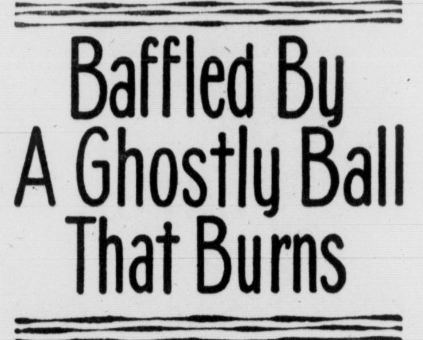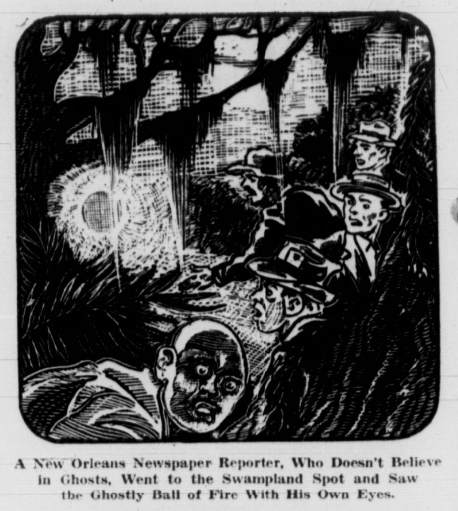
Strange, ghostly balls of fire hovered and vanished on an old gravel road in Bayou Liberty back in 1942. There were many theories about the balls of fire, from swamp gas to static electricity, but here is the story below, as it was published.
Baffled by a Ghostly Ball that Burns
For centuries, men have told tall tales of weird and mysterious balls of fire that suddenly appeared – almost always in remote graveyards or on lonely moors – and then vanished. And now, a new case has just come to light on an isolated gravel road just outside the little town of Slidell, Louisiana.
Walking down this lonely road one dark night, Fritz Schaefer, a 17-year-old youth, was swinging past a woods in the direction of Bayou Liberty when suddenly he stopped short for, not a hundred feet down the road, was a tiny ball of fire. It was about two feet off the ground.
As he watched, in amazement, the ball grew larger and larger. Then it burst in a great globe of flame and disappeared.

The terrified youth lit out for home. Excitedly, he told his father, Fred Schaefer, all about the strange and luminous apparition he had just seen. The older man, at first skeptical, agreed to return with the boy.
Just as the two approached the spot, another fire ball appeared in the identical manner. The elder Schaefer ran toward it, but the glowing ball burst and vanished.
Schaefer couldn’t explain the phenomenon. He had often heard the old men of Slidell talking about mysterious fire-balls that had appeared on the Bayou Liberty road way back in Civil War days, but he had always dismissed such stories as fantastic.
Convinced now that he and his son had seen the real thing, Schaefer went in to the village, rounded up the curious, and the entire party headed back for the lonely road. And they were not disappointed.
Just as they approached, the orange-like ball appeared, rose about six feet in the air and blacked out. Before that night was over, excited residents from all over the countryside had come to see the strange apparition and the story of the fire-balls spread rapidly.
The next night, people came swarming in to Slidell from as far away as New Orleans. The fire-ball proved to be a tolerant entertainer. It put in an appearance, sending the skeptics scudding for the nearest tavern and a stiff drink, and the devout for the closest church and a prayer.
E. H. Zimmerman, credit manager for a large New Orleans department store, saw the fire-ball on three different occasions.
“It came from the ground,” he said, “like a white burst of flame and rolled itself into a ball of fire – then it disappeared.”
A New Orleans newspaper reporter, who made the trip to Bayou Liberty, described his experience: “I was standing with others, about a dozen persons, when the glow came from the road and lifted to about five feet in the air. It became as large as an automobile headlight and then flickered out like a candle. It remained visible for about two minutes, at least.”
The Schaefers, the Slidell residents, and the New Orleans’ visitors, all agree that they have seen the fire-ball – but none can offer an explanation.
The more scientific-minded believe the ghostly sight is nothing more than so called fox fires – the burning of swamp gases.
Oil men, however, report that are no such gases in that area. There is no doubt that the glowing ball has its explanation, if all the facts were known.
The first fire-ball story in that part of Louisiana appeared 80 years ago – and with the recent interest in the latest strange phenomenon, Mrs. David Barry, 93, a former resident of Bayou Liberty, who now is living in New Orleans, told newspapermen how, when she was a girl, such sights scared people in that area half out of their wits.
The old fire-ball legend of the Civil War days had its setting on the same gravel road.
The fire-ball legends in many different sections of the world lead one to wonder whether they all come from the same natural phenomenon. Scientists explain many of these apparitions as nothing more than unusual kinds of lightning or electricity in the air.
It was a long time before the savants gave any credence to the reports of mariners who described what they called “St. Elmo’s fires” on their voyages – flickering balls of fire on the tips of masts, yardarms, or other projecting parts of the ship.
As soon as static electricity was discovered, it became evident that the reports of sailors were undoubtedly correct, and that fire-balls had formed during a storm at sea or when the air was otherwise highly charged.
It is entirely possible that ball-lightning, swamp gas fire-balls, and other phenomenon explain some of the tales of saints as well.
The famous Miracle of Tours, in which a ball of fire is said to have come down from the skies to rest on the head of Saint Martin, can scarcely have been anything else.
This probably explains the ancient stories of shining halos around the heads of saintly individuals.
Lightning fire-balls actually have been photographed by Professor J.C. Jensen of the Department of physics of Nebraska Wesleyan University. One theory, formulated by Professor W.M. Thornton of Armstrong College, in England, is that such phenomena are composed of ozone, in some peculiar state of high electrification.
Still another, based on experiments at the University of Leeds in England, is that they are produced in some unknown way out of highly electrified dust.
Source: Detroit evening times. (Detroit, Mich), 02 Aug. 1942.

